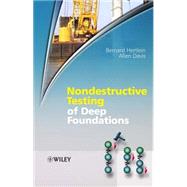
What is included with this book?
In 1992, Mr Hertlein joined STS Consultants, based inVernon Hills, Illinois, where he has continued to design and build test equipment and research new applications for the test techniques that he had helped to introduce to the United States. Mr Hertlein is an active member of several key professional societies. At the time of writing this book, he is a member of the American Society of Civil Engineers, Chairman of the Nondestructive and In-place Testing Committee of the American Society for Testing and Materials (ASTM C9-64), Chairman of the Testing and Evaluation Committee of the Deep Foundations Institute, and Secretary of the Nondestructive Testing Committee of the American Concrete Institute (ACI 228). He also serves as a member of ACI Committee 336: Footings, Mats and Drilled Piers, ASTM Committee C9-47:Self-Consolidating Concrete, D18-11: Deep Foundations and G9-14: Corrosion of Reinforcing Steel. Mr Hertlein has written numerous conference papers and journal articles. He is a regular member of the faculty for the International Association of Foundation Drilling(ADSC-IAFD) Drilled Shaft Inspector’s School and a frequent lecturer at other educational seminars presented byACI International, ADSC regional chapters, the ASCE Geo-Institute and the Deep Foundations Institute.
ALLEN G. DAVIS, PH.D., D.SC., PE
Allen Davis qualified as a geologist and his first career was as prospector for De Beers Corporation in Central Africa. He then converted to Civil Engineering through Geotechnics, gaining his Ph.D. from Birmingham University, UK in that subject. He has had Academic, Research and Industrial experience in fairly equal proportions, including: Professor at the University of Birmingham, UK, for 10 years. Head of the Geotechnical and Highways Research Division, National Center for Building and Civil Engineering Research (CEBTP), Paris, France, for 8 years. Technical and Managing Director, Testconsult CEBTP (UK) for 8 years. He was one of the founding members of Testconsult in 1974. Principal Engineer, STS Consultants, Ltd and Manager for NDE, Madsen, Kneppers Associates, Chicago, Illinois and Salt Lake City, Utah, USA for 6 years. Senior Principal Engineer, Construction Technology Laboratories, Inc. (CTL), Skokie, Illinois, USA for the last 6 years.
At the time of writing this book he was Manager of Nondestructive Evaluation at CTL in Skokie, Illinois. His special interests included vibration problems and realtime data acquisition from dynamic testing of concrete foundations and structures, and he was a member and past Chairman of Committee 228 (Nondestructive Testing of Concrete) of the American Concrete Institute and also a member ofASTMCommittee Nondestructive and In-place Testing. He has published over 80 technical articles and publications to date in the fields of Civil Engineering and Building, Transportation and Materials Resources. Eleven Ph.D. research students (seven in France, four in England) have graduated under his supervision, and he was awarded the degree of Doctor of Science by Birmingham University in 1980. His contributions to the concrete industry and to the work of the ACI were recognized at the October 2004 meeting of the ACI in San Francisco, where it was announced that he had been elected a Fellow of the Institute. Unfortunately ill-health had prevented him from going to San Francisco, and he passed away suddenly at his home a few hours after learning of the fellowship announcement. Rest in peace, old chum.
| FOREWORD. | |||
| PREFACE. | |||
| ABOUT THE AUTHORS. | |||
| ACKNOWLEDGEMENTS. | |||
| PHOTOGRAPHY AND ILLUSTRATION CREDITS. | |||
| 1 INTRODUCTION AND A BRIEF HISTORY. | |||
|
|||
|
|||
|
|||
|
|||
| 2 COMMONLY USED DEEP FOUNDATION CONSTRUCTION METHODS. | |||
|
|||
|
|||
|
|||
|
|||
|
|||
|
|||
| 3 HOW SOILS AFFECT THE CHOICE OF FOUNDATION TYPE. | |||
| 4 TRADITIONAL, VISUAL AND NEW INSPECTION METHODS FOR DEEP FOUNDATION CONSTRUCTION. | |||
|
|||
|
|||
|
|||
|
|||
| 5 A REVIEW OF FULL-SCALE LOAD-TESTING TECHNIQUES. | |||
|
|||
|
|||
|
|||
| 6 HIGH-STRAIN TESTING FOR CAPACITY AND/OR INTEGRITY. | |||
|
|||
|
|||
|
|||
|
|||
|
|||
|
|||
| 7 LOW-STRAIN SURFACE TESTS – SONIC ECHO. | |||
|
|||
| 8 SONIC MOBILITY (IMPULSE RESPONSE). | |||
|
|||
|
|||
|
|||
|
|||
|
|||
| 9 THE IMPEDANCE-LOG ANALYSIS. | |||
| 10 LOW-STRAIN DOWN-HOLE TESTS. | |||
|
|||
|
|||
|
|||
|
|||
|
|||
|
|||
| 11 FIELD MOCK-UPS OF DEEP FOUNDATIONS: CLASS-A PREDICTIONS. | |||
| 12 THE RELIABILITY OF PILE SHAFT INTEGRITY TESTING. | |||
|
|||
|
|||
| 13 CURRENT RESEARCH. | |||
|
|||
|
|||
|
|||
|
|||
|
|||
|
|||
|
|||
|
|||
|
|||
|
|||
| 14 THE PLACE OF NONDESTRUCTIVE TESTING AT THE BEGINNING OF THE 21ST CENTURY. | |||
|
|||
|
|||
|
|||
|
|||
|
|||
| APPENDIX I STRESS-WAVE PROPAGATION IN CYLINDRICAL STRUCTURES. | |||
|
|||
|
|||
|
|||
|
|||
|
|||
| APPENDIX II CONTACT ADDRESSES. | |||
| APPENDIX III STANDARDS REFERRED TO IN THIS BOOK. | |||
|
|||
|
|||
|
|||
|
|||
|
|||
|
|||
| APPENDIX IV SAMPLE SPECIFICATIONS FOR NDT METHODS FOR DEEP FOUNDATIONS. | |||
|
|||
|
|||
| REFERENCES. | |||
| INDEX. |
The New copy of this book will include any supplemental materials advertised. Please check the title of the book to determine if it should include any access cards, study guides, lab manuals, CDs, etc.
The Used, Rental and eBook copies of this book are not guaranteed to include any supplemental materials. Typically, only the book itself is included. This is true even if the title states it includes any access cards, study guides, lab manuals, CDs, etc.